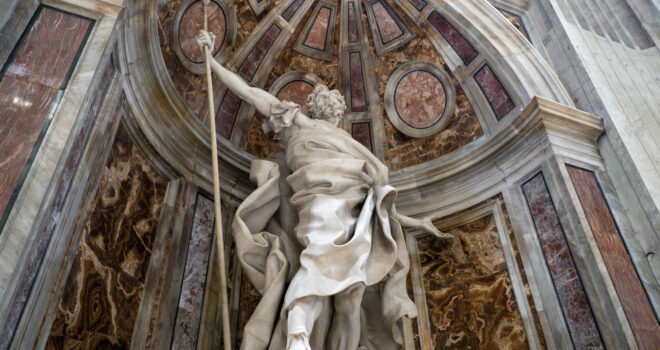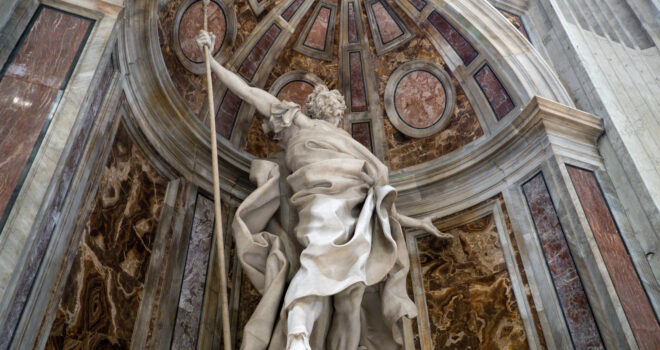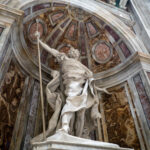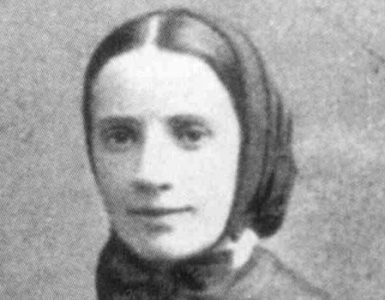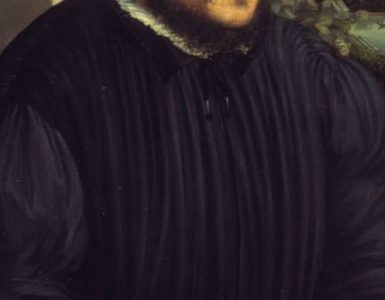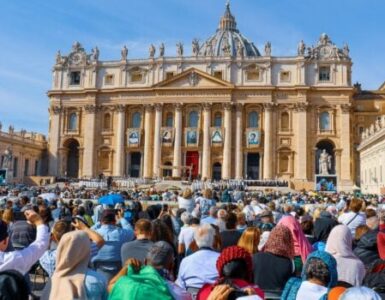Readers will no doubt be familiar with the story of Julius Caesar and his infamous assassination on March 15, emblematic of the chaos, greed, and ambition that drove the Roman Empire.
Several generations later, in a remote outpost of the Roman Empire, the barbarism of the Romans was on full display again, first in the Crucifixion, Death and Resurrection of Our Lord and then in the persecution of Christians. It is then that another Roman government official—this time a centurion—would meet his death on the 15th of March.
The Roman Martyrology (of the old calendar) lists its entry for March 15: “In Caesarea, in Cappadocia, the martyrdom of St. Longinus, the soldier who is said to have pierced our Lord’s side with a lance.”
Derived from the Latin word for lance, the name Longinus refers to the anonymous Roman centurion who was converted at the foot of the cross, exclaiming “Truly, this was the Son of God!”
Tradition tells us that Longinus was healed of his partial blindness when the flow of Blood and water from Our Lord’s side touched his eyes. More importantly, he was healed of his spiritual blindness. As is common in Scripture, faith and healing go together.
Longinus is a patron of converts, and his intercession is asked to gain a conversion, especially dramatic conversions. He is also closely associated with the Sacred Heart, as he pierced this very Sacred Heart, exhausting Its last drop upon the completion of the redemption of the world. Tradition tells us that Longinus was also one of the centurions guarding the Holy Sepulchre, and thus witnessed the Resurrection.
But Longinus’s sudden moment of conversion and intimate witness of the Passion was only the beginning. Longinus would go on to live as a Christian for the remainder of his days, facing his own martyrdom not long after. The traditional story of his death is poetically similar to the story of his own conversion.
After their conversion, Longinus and his companions studied directly under the Apostles, and travelled to Caesarea, Cappadocia (in modern-day Turkey) to preach the gospel. The Roman authorities demanded they sacrifice to pagan idols, which they refused, smashing the idols with an axe. Longinus’s teeth were knocked out and his tongue was cut off, but he was still able to miraculously speak, denouncing the idols and confessing the Faith. Longinus and his companions were then beheaded, professing Christ crucified until the end. It is said that the demons that inhabited the idols struck the local governor blind. As drops of Longinus’s blood pierced the governor’s eyes, he was healed of his blindness, just as the Precious Blood had healed the centurion.
St. Longinus figures prominently in sacred art throughout the ages, including an imposing statue by Gian Lorenzo Bernini in St. Peter’s Basilica.
He is also the titular subject of the 1913 English book of poems St. Longinus the Centurion by Colonel W.L. Greenstreet. Greenstreet’s first-person narrative sets the stage for conversion, showing that Longinus immediately sensed Jesus’s goodness and innocence:
Early that morn
When I commanded Pilate’s guard, the Jews Brought Jesus up for judgment.
All His face Was marred so with blows that I supposed He had been battered in some riotous brawl.
But as I watched, surprised, such royal grace And majesty shone in His countenance,
Although defaced with buffets, that I thought,
Here is no common culprit: Pilate, too, —
Who might, perhaps, without much questioning
Have sentenced some base slave to please the Jews, —
Seeing the unwonted dignity of Christ, Required the Sanhedrim to state His crime;
Whereas the Jews in their presumption thought To have Him sentenced at their mere behest.
No question being asked. But Roman rule,
Unless by some weak hand administered,
Brooks not such rank injustice.
Then the Jews, — Whose answer deserved chastisement, — replied,
“Were He not guilty He would not be here.”
Oh! Pilate vexed me greatly on that day, — So weak and vacillating. —
Well he knew Jesus had done no wrong, and yet he feared the wretched Jews, and dared not set Him free.
Here we see that Longinus was immediately repulsed by the horrible injustice at play in the execution of Our Lord. This cultivation of the virtue of justice, even at a natural level, was preparing Longinus’s soul to accept the fullness of truth, whence that justice derives.
Greenstreet then goes on to narrate Longinus’s impression of Jesus as He was scourged:
Men take their scourging differently;
Some howl from the first, but others laugh in scorn
Until the iron-tipped thongs have ploughed the flesh;
And every strike is torture; then they groan.
But unlike all was Jesus, who in silence bared His back
And with a countenance resolved and firm
Walked to the post, and held His hands aloft
Until the soldiers tied them to the ring,
And then those blows descended. Not a word or cry He uttered, but with upturned face
Gazed skyward, and His lips moved silently
As though He prayed to some invisible God.
Longinus has not yet converted, but the process has begun. He wonders who Jesus is praying to. He is impressed by Jesus’s meekness and steadfastness in suffering, and His compassion for the souls that persecute Him.
Oh, the dreadful cry
From many thousand raging Israelites, — ” Let Him be crucified.”
It brought to mind
The yell of some huge pack of hungry wolves
Such a sound would in most hearts strike terror, not in His, — The prisoner before Pilate, — silent still.
Even when Pilate asked Him ” Whence art thou?”
He did not tremble at the mob’s fierce cry.
Nor kneeling ask protection, but quite calm,
As though the people’s rage concerned Him not,
Spoke of the source of strength, and told the judge His power was given by God. I thought it strange.
But now perceive He would the Praetor help To fear not Caesar but the heavenly powers. And so do justice, — not for Jesus’ sake But Pilate’s.
The centurion is astonished that Jesus seeks to save even Pilate. His actions confound all worldly standards. As Jesus resigned Himself to His fate and comforted the women who were weeping near the foot of the Cross, Longinus comments: “I noted this as strange and wonderful, Beyond my knowledge of the ways of men about to die in torture.”
An encounter with Jesus in His great humility, selflessness, and love drove Longinus to contemplate the identity of the Victim with “eyes so full of love and pity that I knew He took no thought for his own pain or sorrow.”
Nearing the climactic moment, Longinus marvels: “Who was this and who was His father, and why in His pain, when men are wont to curse their torturers, asked that they be pardoned? All day long I pondered on this mystery.”
The centurion witnesses the final moments of Christ: “The firm earth trembled and the crosses swayed, and then the sky grew brighter, and I saw the face of Him I watched change suddenly as though illumined by some wondrous joy.” The final moments of Christ are perceived by Longinus as a victory. He finally concludes: “then I knew that He who hung there dying on the Cross could be none other than the Son of God.”
Greenstreet’s poem illustrates how St. Longinus’s disillusionment with the vice and corruption of his own system, especially the leaders of the Roman Empire, led him to seek goodness and truth elsewhere. His natural virtue was a grace that primed him to accept Jesus Christ, who is Truth and Justice Himself.
His conversion was perfectly completed when he joined his blood with the Precious Blood that he had shed on the day of our redemption.
He entered into eternity on the Ides of March.
✠
Photo: St. Longinus by Bernini in St. Peter’s Basilica by silverfox999 on Shutterstock.


